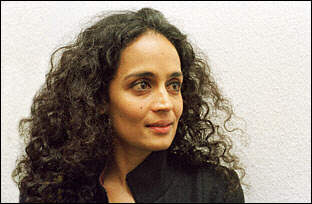http://ning.it/caxFZF
The current unrest in Kashmir has met with an increasingly brutal response from the Indian military. Photograph: Farooq Khan/EPA
The news that the prize-winning Indian author Arundhati Roy may be arrested for her remarks about Kashmir is not surprising. It is a sign of growing Indian intolerance towards the issue. During the current phase of the Kashmiri intifada, the only Indian response to Kashmiri demands for justice and self-determination has been the use of overwhelming military force. More than 112 civilians – mostly youths – have been killed and several thousand injured, mainly by the Indian military and paramilitary.
In the absence of strong international criticism, the Indian state has been emboldened to crush any dissent or demands of justice ferociously. Intimidating Kashmiri civil society has always been part of the standard Indian response, but it has grown exponentially over the last few months. In early July, the police arrested Mian Qayoom, president of the Kashmir Bar Association (the main lawyers' body), for protesting against human rights violations. He was arrested under the draconian Public Safety Act, which authorises incarceration for up to two years if the authorities feel that the detainee may disturb peace and order or threaten the security of the state.
Several other human rights activists, such as Ghulam Nabi Shaheen and political workers remain behind bars, along with hundreds of Kashmiri youths who have been detained for offences such as throwing stones at gun-toting Indian armed forces.
Frustrated by having to treat the mounting casualties amid curfew restrictions and with dwindling medical supplies, a group of doctors at the government medical college in Srinagar staged a peaceful sit-in – only to be accused by the police of various "offences" including rioting and "disobedience to order duly promulgated by public servant". The police also accused them of inciting people and using "anti-national slogans". The largest local newspaper, Greater Kashmir, lamented that creating an atmosphere of intimidation in this way "speaks of the mindset that always contributed to the worsening of the situation". It continued: "Rather than establishing a connect with its people and knowing from them what has gone wrong and how can it be corrected, government, by initiating such actions against people, is only pushing the situation towards worse."
From the very beginning of the current unrest, the government adopted the policy of restricting journalists reporting on demonstrations and brutal government responses. The Indian army and paramilitary forces beat several journalists, refused to respect their curfew passes and even forced closure of leading newspapers as their offices remained locked and the journalists were denied access. In one such incident in July this year, 12 photojournalists working for local, national and international publications suffered serious injuries from security forces trying to stop them recording the demonstrations. One of the BBC's Urdu service journalists, Riaz Masroor, was stopped and beaten by police as he went to collect his curfew pass on 9 July. According the BBC, he suffered a fractured arm.
In September, the Committee to Protect Journalists (CPJ) renewed its call to allow Kashmiri journalists to cover the unrest. This is how Anuradha Bhasin, the executive editor of the Kashmir Times, described the situation to me in an email in September: "The level of intimidation is so high that many reporters have been forcibly doing table [desk-based] stories, mainly operating from the homes. And as an editor, sometimes, even I find that a safer arrangement, given the vulnerability of the reporters in simply stepping out of their homes".
The current phase of intifada has deeply exposed Indian vulnerability in Kashmir. In absence of any Pakistani support to the new generation of Kashmiris, Indian claims to blame Pakistan, Islamic terrorism and Lashkar-e-Taiba have lost credibility even among its own population.
This has provoked several newspaper reports and opinion articles by Indian journalists and commentators that not only question India's brutal tactics but also have shown sympathy to Kashmiri demands. It has created what Roy rightly describes as "panic about many voices", and the threat of charging her with sedition, she says, "is meant to frighten the civil rights groups and young journalists into keeping quiet".
As the "ISI or Laskhar-e-Taiba" theory of the protests becomes increasingly untenable, Kashmiri demands are finding greater resonance within Indian civil society. The threat to Roy may be a crude attempt to prevent such criticism from gathering momentum at a time when Barack Obama is planning a visit to India next month. India is determined to keep Kashmir out of the picture and, to achieve this, intimidation and terror against Kashmiris has already entered another phase.

http://www.guardian.co.uk/commentisfree/2010/oct/28/kashmir-arundhati-roy-india
+++++++++++++++++++++++++
3rd-World-News Blog ~
http://third-world-news.blogspot.com
+++++++++++++++++++++++++
No comments:
Post a Comment